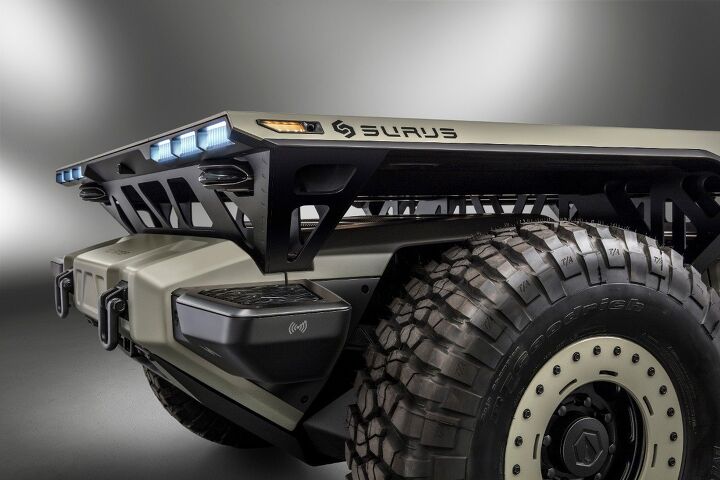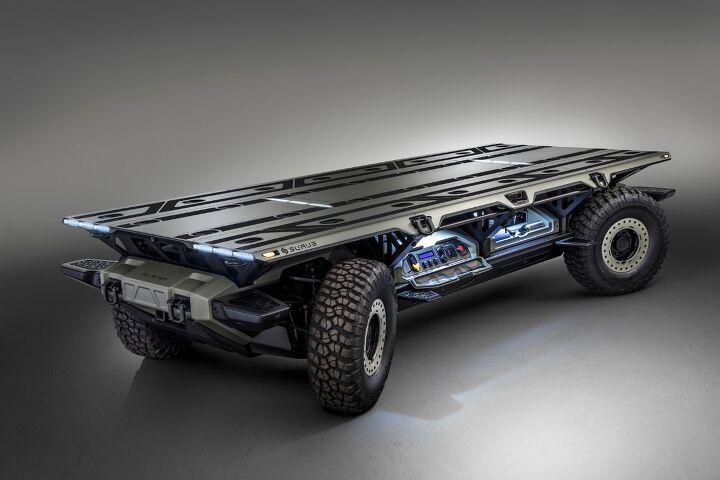Here is General Motors' New 'Truck' Intended for Governmental Use

Regardless of whether it’s brought upon us by climate change, divine intervention, or civil unrest, the end times are right around the corner — and the government is going to need a rugged and versatile vehicle for the impending apocalypse. The automaker with the chops to deliver such a platform? General Motors.
Apparently not Skunk Works levels of classified, GM publicly announced the Silent Utility Rover Universal Superstructure (SURUS) on Friday morning. While not the classic image of a motorized vehicle, the design is intended to serve as the underlying architecture of governmental and commercial transports alike. While the specific government applications are a question mark, the platform’s fuel cell system allows it to run silently with a minimal heat signature — making it ideal for sneaking men and munitions behind enemy lines.
SURUS is also designed to be undeterred by lousy terrain. Its computerized brain allows for autonomous capabilities, in case you want to drive it through a minefield or something. That system also allows it to be lined up in a convoy of other robot-controlled units. It also has external power ports, which would be ideal for camping or construction.
With four-wheel steering and two motors, the lithium-ion battery pack and second generation Hydrotec fuel cell system allows for a total range of 400 miles. Of course, when you do gas up at the motorpool, there will need to be a hydrogen tanker on hand to accomplish the job. That might handicap it for commercial applications, since the United States’ hydrogen fueling network is one step away from nonexistent. But the U.S. Army typically has to take its fuel into whatever region it’s operating in, so it might not be that big of an issue. Then again, I’m not in the army so it could also be a logistical nightmare.
General Motors will showcase SURUS at the fall meeting of the Association of the United States Army (AUSA) from October 9th through the 11th.
It’s hoping officials will embrace the idea of blank slate electric chassis that can be outfitted to perform whatever task is needed. However, the manufacturer already has a few ideas on how to utilize it and included mockups in its announcement of the platform undertaking all manner of roles
[Images: General Motors]

A staunch consumer advocate tracking industry trends and regulation. Before joining TTAC, Matt spent a decade working for marketing and research firms based in NYC. Clients included several of the world’s largest automakers, global tire brands, and aftermarket part suppliers. Dissatisfied with the corporate world and resentful of having to wear suits everyday, he pivoted to writing about cars. Since then, that man has become an ardent supporter of the right-to-repair movement, been interviewed on the auto industry by national radio broadcasts, driven more rental cars than anyone ever should, participated in amateur rallying events, and received the requisite minimum training as sanctioned by the SCCA. Handy with a wrench, Matt grew up surrounded by Detroit auto workers and managed to get a pizza delivery job before he was legally eligible. He later found himself driving box trucks through Manhattan, guaranteeing future sympathy for actual truckers. He continues to conduct research pertaining to the automotive sector as an independent contractor and has since moved back to his native Michigan, closer to where the cars are born. A contrarian, Matt claims to prefer understeer — stating that front and all-wheel drive vehicles cater best to his driving style.
More by Matt Posky
Latest Car Reviews
Read moreLatest Product Reviews
Read moreRecent Comments
- Jkross22 It used to be depreciation was the most expensive part of car ownership. Seems like those days are over (New EVs and lux cars excluded). Maintenance + insurance have taken over. Dealerships offering 2 years of maintenance means nothing. That's $200 tops. It's the unexpected repairs - a wiring harness, computer module, heater core, AWD problems - that will cost dearly. Brakes can be expensive since many cars now can't have rotors resurfaced. Even independents are charging a lot for this work.
- FreedMike VW tossed in two years' maintenance on my car, and the next one's due after the lease is up. But all the car's needed has been oil changes and tire rotations. Unfortunately, the OEM tires (Hankook Kinergy) were unrepentant trash and needed to be replaced at around 23,000 miles. So...my maintenance cost over over a little under three years has been t $800 for the new tires. That sucks, but the new tires (Goodyear Eagle Sport) are a massive upgrade over the Hankooks. Ah well.
- Rna65689660 2015 Ford Edge V6 AWD: 176k miles. One set of Cooper tires, rear brakes, rear struts. Oil change every 10k miles. 1 battery, trans and coolant flush at 100k.2013 MINI Cooper S 6mt: 117k miles. Oil change every 10k, 4 sets tires, 3 sets brakes, rotors twice, 2 windshields,1 HVAC rheostat, 1 cv boot cover. This week pcv valve with valve cover and coolant thermostat, lower radiator hose.The MINI gets driven harder.
- Zipper69 Is Toyota trying to squeeze into a space between the mid and full size trucks, both ICE and hybrid?That market can only be sliced so thin until it's a continuous, amorphous mélange and a confused market and irritated buyers.
- FreedMike I have it on good authority that Subaru asked Subaru buyers what they wanted out of the Legacy, and they came up with the following cryptic mission: "So outdoorsy I can feel the poison ivy." Subsequently, they tried to add at least 10 square yards of black plastic cladding to the side of the Legacy, creating the Legacy "Lost In The Woods" edition, but the supplier pulled out, thus sealing the Legacy's fate. RIP.






































Comments
Join the conversation
Wonder what the 'Real People, Not Actors' focus groups will think of it?
If you do some digging and research you'll learn some things: 1) The US military believes climate change is very real, they really don't care what you or the administration thinks 2) The US military believes that fossil fuels will eventually run out, they really don't care what you or the administration thinks 3) The US military has been investing heavily in non-fossil fuel technology for over a decade now, they really don't care what you or the administration thinks 4) This platform was built for a very specific military purpose. You're not looking at the next HUMVEE of deuce-and-a-half. Modern warfare has created tactical situations where a vehicle needs to be silent for insertion and extraction, on station for days, produce electricity and water silently to support the special forces unit in theater, and not produce a heat signature. GM didn't yank this out of their @$$ 5) The military has been trying to develop operational ready fuel cells for tactical vehicles for over 30 years, they are pretty invested in the technology (again, do some research)